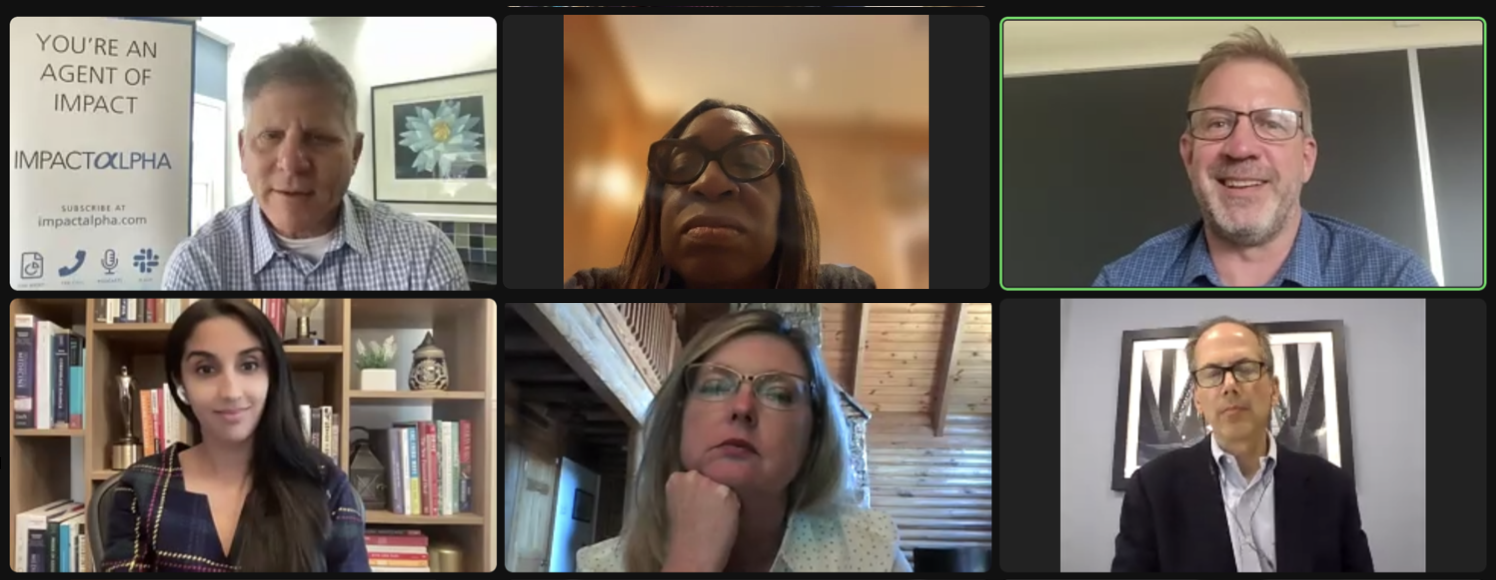ImpactAlpha, Jun. 22 – Even as some politicians ramp up anti-ESG rhetoric, asset owners and allocators are signaling an appetite for investment strategies with greater consideration of climate and racial equity risks.
Investors are seeking high-impact strategies in the $4 trillion market for municipal bonds.
“We’re really seeing demand spike,” said Preeti Bhattacharji of J.P. Morgan Private Bank on ImpactAlpha’s Call No. 51 (made possible with support from Robert Wood Johnson Foundation).
Bhattacharji, who advises more than 3500 institutions and high-net worth individuals, sees a potentially fleeting opportunity to connect a generational rotation into fixed-income to maturing strategies for impact and racial equity in muni markets.
“I’m worried we will miss the moment if we aren’t able to figure out how to build the infrastructure to connect the supply and the demand.”
Bhattacharji joined Harvard’s David Wood and SEIU’s Renaye Manley, Breckinridge’s Tim Coffin, Heron’s Barbara VanScoy, and Lourdes Germán of the Public Finance Initiative to explore “racial equity audits” and other strategies asset owners can use to move muni bond managers, underwriters and issuers toward action and accountability.
Auditing racial equity
In the years since the murder of George Floyd and the summer of social uprising that followed, institutional investors have sought to go beyond typical diversity, equity and inclusion strategies, says Wood, who leads Harvard’s Initiative for Responsible Investment.
Wood has been working with pension funds, labor unions and endowments to identify opportunities for institutional investors to nudge the investment managers and the market toward greater racial equity, including in municipal bond markets.
One emerging model: The “racial equity audit” that shareholder activists have used to trigger action at some of the largest corporations, including Amazon, Google, Walmart, BlackRock, Facebook, Citigroup and JPMorgan Chase. The third-party assessments spotlight the adverse impacts a company’s products and practices have on communities of color – and ways to remedy them.
Now, Wood, Renaye Manley of the Service Employees International Union, who has led efforts to introduce racial equity audit shareholder proposals, and others are looking to apply the audit to the fixed income strategies of financial institutions.
“How do we take information about what financial institutions are doing in the municipal bond market and make that integral to what investors are asking of the publicly traded corporations they hold?” Wood asked on the call. “The big publicly traded underwriting functions are places that can help define the space for everybody.”
Manley says that for asset owners, it’s about risk mitigation. “We see a lot of opportunity for folks in the municipal bond market to participate in racial equity audits,” she said. Investors want companies “to identify and then mitigate the risks that may come with exposure to racial inequity and injustice,” she said.
RFPs and Letters of Intent
Racial equity audits are just one tool in the allocator tool set.
Nathan Cummings Foundation, for example, put out a public request for proposals from outsourced chief investment officers to manage its $450 million endowment and “co-create a mission-aligned investment strategy.” The foundation partnered with Black-owned consulting firm Frontline Solutions to ensure the process reflected a commitment to equity and invited joint proposals to overcome factors that have historically limited what firms could apply, including assets under management.
To signal its aspirations for racial equity, Heron Foundation has used a fixed-income letter of intent to ask managers to consider use of proceeds, track record of the issuer and needs of the community in selecting municipal bonds. “Ultimately, we are seeking managers who can formulate an informed, independent opinion on social performance and work in partnership with Heron,” the foundation wrote in the letter.
Investment mandates, another tool at an allocator’s disposal, can be used to embed aspirations into strategies, says Bhattacharji.
One limitation, notes Bhattacharji, is investors’ aversion to fees. “It takes money to pay for audits. It takes money to do this resourcing. It takes money to do this research and this reporting,” said Bhattacharji. “I’m not sure as a collective ecosystem we’ve figured out how to articulate that.”
Words of caution
Lourdes Germán of Public Finance Initiative has been working closely with issuers to define racial equity best practices in bond issuances.
“What I challenge us all to think about is do issuers who are doing these deals fully have access to information on the changing tenor of investor expectations and demands?” she said.
“We don’t want to create an environment where communities who are working on a continuum towards racial equity progress thoughtfully… would find themselves disadvantaged from a pricing standpoint because investors are looking for something that’s a standard in a market that is very much emergent,” said Germán.
Barbara VanScoy, who manages a portfolio of fixed-income investments at Heron Foundation, was likewise concerned that tools like racial equity audits could impose unmeetable expectations on resource-poor issuers. This spring, for example, S&P put 150 issuers on ‘credit watch’ for lack of timely disclosure.
“I’m afraid that some of these issuers just do not have the capacity for you to pile on even more things for them to complete,” she said.
VanScoy would rather asset managers look at use of proceeds and how the issuer behaves, and have more conversations and interactions. “Sometimes it’s not that the issuer isn’t doing something, it’s just lack of disclosure, because sometimes they don’t know that investors care.”
VanScoy encourages investors to say, ‘we care about this information, we want to know what you’re doing. What are you doing in your community that is bridging the racial wealth divide?’
Breckinridge’s Tim Coffin brought the discussion back to materiality. “What we can do with this data that you’re talking about is really look for the material factors of what you’re talking about that actually make these better medium to long term investments.”
“What are they using the proceeds for? How essential is the public project?” He asked. “It’s really this notion that a community, even if it faces a kind of a stressful economic cycle, is going to stand behind the most essential projects, like K through 12 education.”
Resources shared on The Call:
Racial Equity as a Topic for Responsible Investment (Initiative for Responsible Investment)
Municipal Bond Markets and Racial Equity: A Framework (Public Finance Initiative)
Croatan Institute’s BLAISE Initiative
Agents of Impact who joined The Call include:
Kyle Mylius and Leslie Rosenberg of Humanize Wealth, Ibrahim Rashid of Marquette Associates, Robert Morris of Simba Technologies, Alison Lingane of Project Equity, Will Toaspern of UC Berkeley Goldman School of Public Policy and Labor Center, Cathi Kim of Inclusiv, Tim Ferguson of Tilt Investments, consultant Margaret Bowman, Will Chase of Charted Impact, Ina Lee of the GIIN, Kreg Kerr of Westfuller, consultant Maya Beasley, Noradeen Farlekas of Fairfield University, Marc Tannous of Silver Leaf Partners, advisor Calvin Vismale, Sean Kelleher of SustainEnergyFund, John Sherman of Sherman Impact Consulting, Phil Kirshman of Manchester Capital Management, Andrea McGrath of Amplified Impact, David Sand of Community Capital Management, Kevin Jones of Neighborhood Economics











